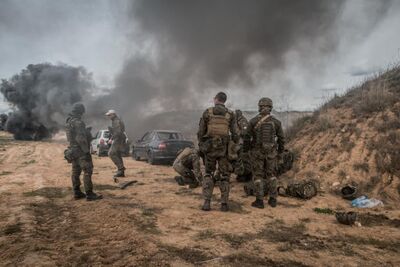Operation Sagaris
Operation Sagaris (known sometimes as the Battle of the Kenderes Steppe) was an offensive launched by the Syaran Commonality Armed Forces during the Zemplen War. With more than half a million troops involved on each side, it was the largest single battle fought in the conflict.
In the spring of 2009 Syara had launched Operation Synaspismos and delivered a crushing victory against Ruvelka's Army Group South. Despite the failure to capture Aszód and the Operation Pylooros, Syaran Central Command believed a sweeping offensive into the Ruvelkan steppe south of the Matra Mountains would allow Syara to circumnavigate the mountainous obstacles of the Kurillas and allow the Syarans to push into eastern Ruvelka. Field Marshal Daniel Mladenov Todorov, commanding officer of Army Group Gamma, envisioned a major encirclement of the bulk of Army Group South to destroy Ruvelka's main fighting force in the region, with the added bonus of cutting off the supply routes from Ruvelka-aligned Mansuriyyah, which flowed through the city of Kenderes. Recognizing the danger, the Ruvelkan Imperial General Staff hundreds of thousands of reinforcements into the region, boosting Ruvelkan troop numbers to over 800,000 men and women. Army Group Gamma fielded some 600,000 troops in addition to nearly 4,000 tanks and an additional 8,500 armored vehicles, many of them donated from units from Army Group Beta.
The Syarans began their offensive on 17 April 2009, expecting that the wide open steppe would be well suited to their mechanized forces and maneuvers, but stiff Ruvelkan resistance resulted in limited gains for the first few weeks. In response the Ruvelkans executed a phased withdrawal on 28 April, allowing the Syarans to overextend themselves before launching a major counterstroke with the Eleventh and Fifteenth Armies. Devesated by Ruvelkan helicopter gunships, Syaran armor was unable to achieve a breakthrough and was forced to retreat. A Ruvelkan counter-offensive forced the Syarans back to the foothills of the Matra Mountains, and the fighting died down around 7 May.
The Syaran defeat came as a surprise to both Syaran and Ruvelkan commanders, who expected that the Syarans would enjoy a significant advantage in the open steppe compared to the thick forests and rugged mountains of much of the rest of Ruvelka. In the aftermath of the operation, Field Marshall Todorov came under fire from the SCAF for his poor planning and leadership during the course of the battle, though he ultimately remained in command of Army Group Gamma for the remainder of the war. The losses Syara suffered during the campaign, coupled with casualties during the Battle of Sagerejo and Operation Harpe led Central Command to suspend further major offensives a few months later.
Background
During the opening months of the Zemplen War Army Group Gamma had taken a relatively minor role in the conflict, confined by the mountainous terrain of southern Ruvelka to short range offensive operations. Although the Army Group took part in pitched fighting during the Ruvelkan Winter Counter-Offensive, it was not a major target for the Imperial Armed Forces of Ruvelka. As a result of its relative good standing compared to the other Syaran Army Groups, Gamma was considered the best option to spearhead further Syaran offensives. In Operation Synaspismos the Syarans furthered their gains in southern Ruvelka with a decisive victory over Army Group South, forcing the Ruvelkans to cede much of the western Matra Mountains to Syaran control. Following Syara's crushing victory at Annohk Valley, General Tibor Fehér ordered Army Group South to withdraw further south and east, allowing the Syarans to establish a strong anchor point along the western Matra Range. The encirclement of Aszód and the subsequent siege further depleted Ruvelkan forces in the region, although the failure to capture the city would force the Syaran 10th Army to permamnently commit the XXXV Corps under Lt. General Zaharinka Mitrovska to surrounding the port.
Although the offensive left Army Group Gamma in a good defensive posture, the mountainous terrain it occupied was unfamiliar to many Syaran commanders and left the Army Group in a cramped strategic position. As the winter subsided and the spring approached, Syaran Central Command devised plans for a second wave of offensives intended to destroy the bulk of the Ruvelkan Imperial Army. All the Army Group commanders were summoned to Zovahr between 13-15 March 2009 to discuss the coming operations and for their input. Chief of Staff Vakhtang Avakian led the discussion and outlined the desired course of action; all three Army Groups would launch a major strategic offensive in sequence intended to destroy the Ruvelkan Army Group opposite their forces. The decimation of Ruvelka's ground forces would cripple the Principality's ability to wage war, and compell Debrecen to sue for peace. With over 3.5 million men in uniform, over 2,000 manned aircraft and 25,000 armored fighting vehicles, the logistical burden of supporting concurrent offensives was deemed too significant. Instead, the Army Groups would launch their offensives in sequence, allowing resources and reserves to be shifted elsewhere once the fighting in a particular sector was complete. Army Group Gamma, being the most combat ready of the Syaran formations, was to launch the first strike against Ruvelka's Army Group South.
As was the case with the Syaran military, the exact details of the operations were left to their respective commands to be devised. Field Marshal Daniel Mladenov Todorov, commander of Army Group Gamma, returned to Army Group Headquarters on 17 March and directed his Opperations Senior Officer Major General Božidar Dukić to devise a plan for a major offensive aimed at the destruction of Army Group South, with input from Gamma's Chief of Staff Pavel Zajkovski.
